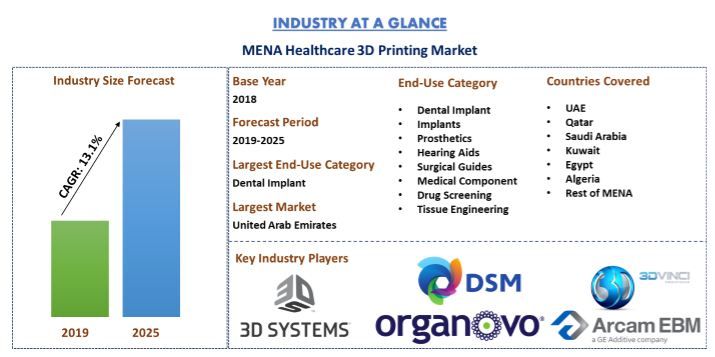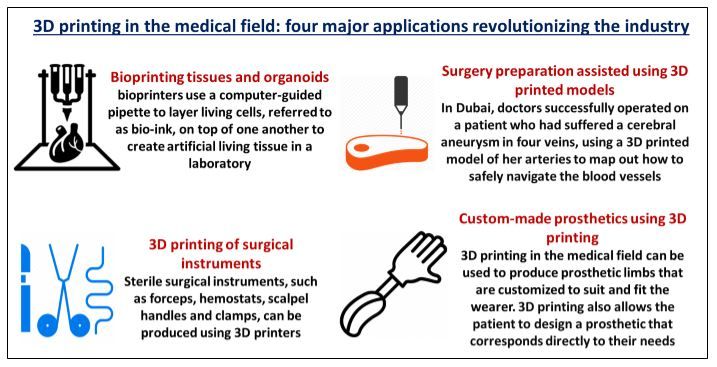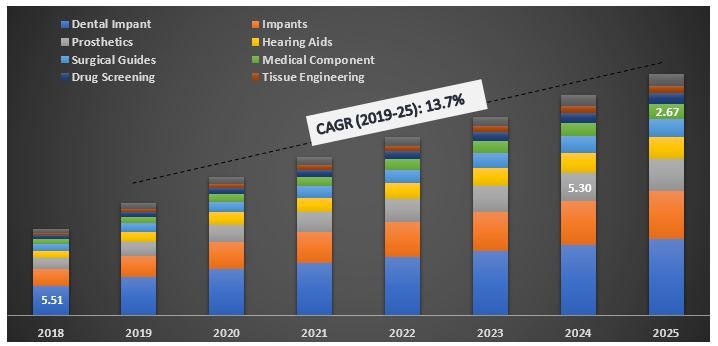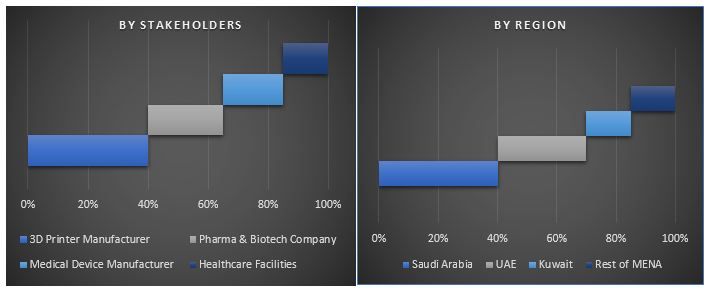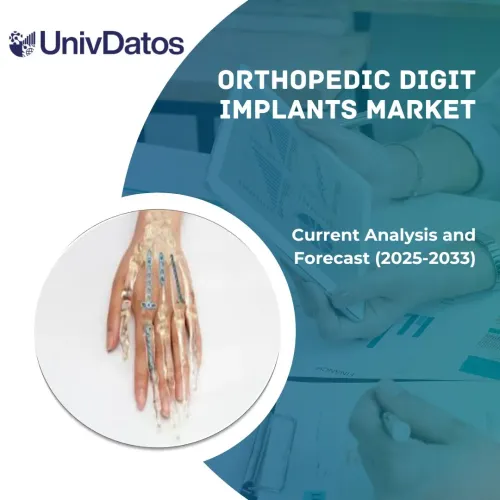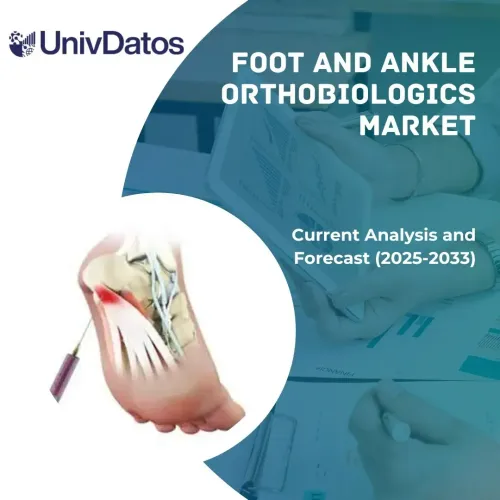- Trang chủ
- Về chúng tôi
- Ngành
- Dịch vụ
- Đọc
- Liên hệ với chúng tôi
Thị trường In 3D trong lĩnh vực Chăm sóc Sức khỏe: Kịch bản Hiện tại và Dự báo (2019-2025)
Nhấn mạnh vào Thành phần ((Sản phẩm (Máy in Chuyên nghiệp/Công nghiệp, Máy in 3D Cá nhân/Để bàn), Vật liệu (Polymer, Nhựa, Kim loại và Hợp kim, Gốm sứ, Vật liệu khác), Công nghệ (Mô hình hóa lắng đọng nóng chảy, Thiêu kết Laser chọn lọc, In nổi lập thể, Nóng chảy chùm tia điện tử, Sản xuất vật thể nhiều lớp, Mực in sinh học, Các công nghệ khác), Ứng dụng (Sản xuất các bộ phận chức năng, Lắp ráp và Lắp ghép, Mô hình hóa nguyên mẫu, Nghiên cứu, Đúc khuôn mẫu, Hỗ trợ trực quan, Mô hình hóa thuyết trình, Các ứng dụng khác), Lĩnh vực thực hành (Thiết bị y tế, Dược phẩm, Khoa học sinh học), Danh mục sử dụng cuối (Cấy ghép nha khoa, Cấy ghép, Bộ phận giả, Máy trợ thính, Hướng dẫn phẫu thuật, Linh kiện y tế, Sàng lọc thuốc, Kỹ thuật mô, Khác), Người dùng cuối (Trung tâm Y tế & Phẫu thuật, Công ty Dược phẩm & Công nghệ sinh học, Tổ chức Học thuật & Nghiên cứu) và Quốc gia
Thị trường in 3D trong lĩnh vực chăm sóc sức khỏe khu vực MENA được định giá 87,07 triệu đô la Mỹ vào năm 2018 và dự kiến sẽ đạt 234,2 triệu đô la Mỹ vào năm 2025, thể hiện mức tăng trưởng CAGR là 13,1% trong giai đoạn dự báo (2019-2025). Công nghệ in 3D đã chứng kiến sự tăng trưởng đáng kể và sẵn sàng vươn lên những tầm cao mới trong những năm tới ở khu vực MENA. Các quốc gia như UAE, Qatar và Ả Rập Saudi sẵn sàng nắm bắt các cơ hội vốn có trong in 3D và do đó đang đạt được lợi thế hàng đầu trong các tiến bộ công nghệ. Hơn nữa, khu vực này thể hiện tiềm năng to lớn để thay đổi triệt để cách các thiết bị y tế được sử dụng để điều trị cho bệnh nhân. Kỹ thuật này đã nổi lên như một trong những lựa chọn hiệu quả về chi phí cho ngành thiết bị y tế và do đó đã tác động tích cực đến lĩnh vực chăm sóc sức khỏe. Nhu cầu ngày càng tăng đối với các sản phẩm dành riêng cho bệnh nhân trong phẫu thuật chỉnh hình và hàm mặt cùng với những tiến bộ nhất quán trong các công nghệ tiên tiến đã thúc đẩy đáng kể hiệu quả hoạt động của thị trường in 3D trong lĩnh vực chăm sóc sức khỏe khu vực MENA. Sự tăng trưởng của thị trường là do kỹ thuật 3D đang bùng nổ trong lĩnh vực chăm sóc sức khỏe, sự hỗ trợ của chính phủ, tiến bộ công nghệ trong ngành chăm sóc sức khỏe (đặc biệt là thiết bị y tế), tăng chi tiêu cho công nghệ in 3D, chuỗi cung ứng nhanh hơn và giảm thời gian giao hàng, v.v. Công nghệ này đã phát triển mạnh mẽ trên nhiều ngành sản xuất, trong đó chăm sóc sức khỏe là một trong những lĩnh vực chính. Hơn nữa, công nghệ tiên tiến đã cho phép các nhà sản xuất nâng cao sản xuất tại địa phương. Tuy nhiên, chi phí cao liên quan đến in 3D về máy in 3D và sự thiếu hụt nguồn lực trong in 3D và sự thiếu hiểu biết về công nghệ trong in 3D đặt ra một số yếu tố hạn chế, cản trở tiềm năng của thị trường in 3D trong lĩnh vực chăm sóc sức khỏe khu vực MENA. Vào tháng 4 năm 2016, Dubai đã công bố kế hoạch đầy tham vọng trở thành một nhà lãnh đạo khu vực và quốc tế về in 3D, với lĩnh vực y tế là trọng tâm cốt lõi. Papantoniou dự đoán in 3D sẽ có tác động đáng kể đến hai vấn đề sức khỏe quan trọng của UAE là phẫu thuật tái tạo và phòng ngừa bệnh tiểu đường.
In 3D trong lĩnh vực y tế
“Trong số các loại thành phần, phân khúc sản phẩm (Máy in) chiếm ưu thế trên thị trường, chiếm 36,4% thị phần vào năm 2018”
Dựa trên Thành phần, báo cáo phân chia thị trường in 3D trong lĩnh vực chăm sóc sức khỏe khu vực MENA thành Sản phẩm, vật liệu, dịch vụ và các loại khác (phần mềm). Năm 2018, phân khúc sản phẩm chiếm ưu thế trên thị trường và dự kiến sẽ duy trì sự thống trị trong suốt giai đoạn dự báo 2019-2025.
“Trong số các loại máy in, Máy in công nghiệp/chuyên nghiệp là loại máy in được sử dụng nhiều nhất, tiếp theo là máy in để bàn trong thị trường in 3D trong lĩnh vực chăm sóc sức khỏe khu vực MENA”
Dựa trên sản phẩm (máy in), thị trường được phân khúc thành Máy in chuyên nghiệp/công nghiệp và Máy in 3D cá nhân/để bàn. Máy in chuyên nghiệp/công nghiệp chiếm ưu thế trên thị trường in 3D trong lĩnh vực chăm sóc sức khỏe khu vực MENA và dự kiến sẽ duy trì sự thống trị của chúng trong suốt giai đoạn được phân tích. Máy in 3D để bàn dự kiến sẽ chứng kiến mức tăng trưởng CAGR là 14,8% trong giai đoạn được phân tích.
“Trong số các loại vật liệu, phân khúc polyme tạo ra doanh thu 7,54 triệu đô la Mỹ vào năm 2018”
Dựa trên loại vật liệu, thị trường được phân khúc thành polyme, nhựa, kim loại và hợp kim, và gốm sứ. Năm 2018, phân khúc polyme nắm giữ thị phần dẫn đầu trên thị trường vật liệu in 3D trong lĩnh vực chăm sóc sức khỏe khu vực MENA vì chúng thể hiện khả năng thâm nhập và khả năng tiếp cận người dùng lớn nhất trong in 3D. Tuy nhiên, phân khúc gốm sứ dự kiến sẽ chứng kiến mức tăng trưởng CAGR vượt bậc là 15,1% trong giai đoạn được phân tích. Dựa trên loại dịch vụ, thị trường được phân khúc thành Thiết kế và sản xuất tùy chỉnh và Dịch vụ hậu mãi. Năm 2018, Thiết kế và sản xuất tùy chỉnh tạo ra doanh thu 9,41 triệu đô la Mỹ trên thị trường in 3D trong lĩnh vực chăm sóc sức khỏe khu vực MENA.
“Trong số các công nghệ, công nghệ Mô hình hóa lắng đọng nóng chảy chiếm ưu thế trên thị trường với 31,6% thị phần vào năm 2018”
Dựa trên công nghệ, thị trường được chia thành Lập thể in, Thiêu kết Laser Chọn lọc, Nấu chảy chùm tia điện tử, Mô hình hóa lắng đọng nóng chảy, Sản xuất vật thể nhiều lớp, In sinh học và Các công nghệ khác. Mô hình hóa lắng đọng nóng chảy chiếm thị phần nổi bật vào năm 2018 vì đây là một trong những công nghệ nổi bật và thân thiện với người dùng, được sử dụng rộng rãi để tạo ra các vật thể in 3D.
“Trong số các ứng dụng, Bộ phận chức năng được dự đoán sẽ chiếm ưu thế trên thị trường in 3D trong lĩnh vực chăm sóc sức khỏe khu vực MENA vào năm 2025.”
Dựa trên ứng dụng, thị trường được chia thành các bộ phận chức năng, lắp ráp và lắp, mô hình hóa nguyên mẫu, nghiên cứu, đúc khuôn, hỗ trợ trực quan, mô hình hóa bản trình bày và các ứng dụng khác. Năm 2018, sản xuất Bộ phận chức năng chiếm ưu thế trên thị trường công nghệ in 3D trong lĩnh vực chăm sóc sức khỏe khu vực MENA, tạo ra doanh thu 29,46 triệu đô la Mỹ.
“Công nghệ in 3D chủ yếu được sử dụng để sản xuất thiết bị y tế”
Dựa trên lĩnh vực thực hành, thị trường in 3D trong lĩnh vực chăm sóc sức khỏe khu vực MENA được chia thành thiết bị y tế, dược phẩm và khoa học sinh học. Năm 2018, phân khúc thiết bị y tế chiếm ưu thế trong việc áp dụng công nghệ in 3D, chiếm 56,8% thị phần. Tuy nhiên, phân khúc khoa học sinh học dự kiến sẽ chứng kiến mức tăng trưởng CAGR cao nhất trong giai đoạn dự báo 2019-2025.
“Trong số các mục đích sử dụng cuối, cấy ghép nha khoa là thị trường lớn nhất cho công nghệ in 3D trên thị trường in 3D trong lĩnh vực chăm sóc sức khỏe khu vực MENA”
Dựa trên danh mục mục đích sử dụng cuối, thị trường được chia thành cấy ghép nha khoa, cấy ghép, bộ phận giả, máy trợ thính, hướng dẫn phẫu thuật, các thành phần y tế, sàng lọc thuốc, kỹ thuật mô và các loại khác. In 3D được triển khai phần lớn để sản xuất cấy ghép nha khoa, do đó, cấy ghép nha khoa chiếm ưu thế trên thị trường in 3D trong lĩnh vực chăm sóc sức khỏe khu vực MENA, tạo ra doanh thu 29,94 triệu đô la Mỹ vào năm 2018
Quy mô thị trường in 3D trong lĩnh vực chăm sóc sức khỏe theo danh mục mục đích sử dụng cuối, khu vực MENA 2018-2025 (triệu đô la Mỹ)
“Các trung tâm y tế & phẫu thuật là những người dùng cuối chính của công nghệ in 3D”
Các trung tâm y tế & phẫu thuật, các công ty dược phẩm & công nghệ sinh học và các tổ chức học thuật & nghiên cứu là những người dùng cuối chính của công nghệ in 3D. Năm 2018, các trung tâm y tế & phẫu thuật chiếm ưu thế trong việc sử dụng công nghệ in 3D và dự kiến sẽ duy trì sự thống trị của chúng trong suốt giai đoạn dự báo.
“UAE là thị trường sinh lợi nhất cho công nghệ in 3D trên thị trường chăm sóc sức khỏe khu vực MENA”
Để phân tích chuyên sâu về công nghệ, phân tích chi tiết cấp quốc gia đã được thực hiện cho các quốc gia bao gồm UAE, Qatar, Ả Rập Saudi, Kuwait, Ai Cập, Algeria và phần còn lại của khu vực MENA. UAE tạo ra doanh thu 16,02 triệu đô la Mỹ vào năm 2018. Tuy nhiên, Algeria dự kiến sẽ chứng kiến mức tăng trưởng CAGR cao nhất là 16,1% trong giai đoạn dự báo 2019-2025.
Bối cảnh cạnh tranh - 10 công ty hàng đầu trên thị trường
3D Systems Corporation, Arcam AB, Royal DSM N.V., Stratasys Ltd., Organovo Holdings, Inc, Mcor Technologies Limited, Voxeljet AG, 3DVinci Creations, AddUp và Jumbo 3D manufacturing là một số công ty nổi bật hoạt động trên thị trường in 3D trong lĩnh vực chăm sóc sức khỏe khu vực MENA. Một số hoạt động M&A cùng với quan hệ đối tác đã được các công ty này thực hiện để tạo điều kiện cho khách hàng sử dụng các sản phẩm công nghệ cao và tiên tiến.
Lý do nên mua:
- Quy mô thị trường hiện tại và tương lai từ năm 2019 đến năm 2025 về giá trị (đô la Mỹ)
- Phân tích kết hợp nghiên cứu thứ cấp chuyên sâu và đầu vào từ nghiên cứu sơ cấp thông qua các nhà lãnh đạo quan điểm chủ chốt của ngành
- Chi tiết cấp quốc gia về việc áp dụng tổng thể thị trường in 3D trong lĩnh vực chăm sóc sức khỏe và một số nghiên cứu điển hình về bệnh nhân đã áp dụng in 3D trong lĩnh vực chăm sóc sức khỏe
- Đánh giá nhanh về hiệu suất tổng thể của ngành trong nháy mắt
- Phân tích chuyên sâu về những công ty chủ chốt trong ngành
- Phân tích chi tiết về khung pháp lý, động lực, hạn chế, xu hướng chính và cơ hội hiện hành trong ngành
- Kiểm tra mức độ hấp dẫn của ngành với sự trợ giúp của phân tích Năm lực lượng của Porter và các công ty khởi nghiệp
- Nghiên cứu bao gồm toàn diện thị trường trên các phân khúc và phân khúc phụ khác nhau của công nghệ
- Quốc gia được đề cập: Các Tiểu vương quốc Ả Rập Thống nhất, Qatar, Ả Rập Saudi, Kuwait, Ai Cập, Algeria và phần còn lại của khu vực MENA
Tùy chọn tùy chỉnh:
UMI hiểu rằng bạn có thể có nhu cầu kinh doanh riêng, do đó chúng tôi cũng cung cấp các giải pháp hoàn toàn tùy chỉnh cho khách hàng. Thị trường in 3D trong lĩnh vực chăm sóc sức khỏe khu vực MENA có thể được tùy chỉnh theo cấp quốc gia hoặc bất kỳ phân khúc thị trường nào khác.
Mục lục
Việc phân tích thị trường lịch sử, ước tính thị trường hiện tại và dự báo thị trường tương lai cho Thị trường In 3D Chăm sóc Sức khỏe MENA dựa trên ba bước chính được thực hiện để tạo và phân tích xu hướng áp dụng công nghệ In 3D trong lĩnh vực Chăm sóc Sức khỏe ở các quốc gia lớn của khu vực MENA. Nghiên cứu thứ cấp toàn diện cũng đã được tiến hành để thu thập các số liệu thị trường lịch sử nhằm ước tính quy mô thị trường hiện tại. Thứ hai, để xác thực những hiểu biết sâu sắc này, nhiều phát hiện và giả định đã được xem xét. Hơn nữa, các cuộc phỏng vấn sơ cấp toàn diện cũng đã được thực hiện với các chuyên gia trong ngành trên toàn bộ chuỗi giá trị của thị trường In 3D Chăm sóc Sức khỏe ở khu vực MENA. Sau khi giả định và xác thực các số liệu thị trường thông qua các cuộc phỏng vấn sơ cấp, phương pháp tiếp cận từ dưới lên đã được sử dụng để dự báo quy mô thị trường hoàn chỉnh của thị trường In 3D Chăm sóc Sức khỏe MENA. Sau đó, các phương pháp phân tích chi tiết thị trường và phân tích dữ liệu tam giác đã được áp dụng để ước tính và phân tích quy mô thị trường của các phân khúc và phân đoạn phụ mà ngành liên quan. Phương pháp luận chi tiết được giải thích dưới đây:
Phân tích Quy mô Thị trường Lịch sử
Bước 1: Nghiên cứu Chuyên sâu về Nguồn Thứ cấp:
Nghiên cứu thứ cấp chi tiết đã được thực hiện để thu thập quy mô thị trường lịch sử của thị trường In 3D Chăm sóc Sức khỏe MENA thông qua các nguồn nội bộ của công ty như báo cáo thường niên & báo cáo tài chính, các bài thuyết trình về hiệu suất, thông cáo báo chí, v.v., và các nguồn bên ngoài bao gồm tạp chí, tin tức & bài báo, ấn phẩm của chính phủ, ấn phẩm của đối thủ cạnh tranh, báo cáo ngành, cơ sở dữ liệu của bên thứ ba và các ấn phẩm đáng tin cậy khác.
Bước 2: Phân khúc Thị trường:
Sau khi thu thập quy mô thị trường lịch sử của thị trường In 3D Chăm sóc Sức khỏe MENA, một phân tích thứ cấp chi tiết đã được tiến hành để thu thập thông tin chi tiết về thị trường lịch sử và chia sẻ cho các phân khúc & phân đoạn phụ khác nhau cho các quốc gia lớn trên khắp khu vực MENA. Các phân khúc chính được bao gồm trong báo cáo là thành phần, loại công nghệ, ứng dụng, danh mục sử dụng cuối, lĩnh vực thực hành và người dùng cuối. Phân tích chi tiết hơn ở cấp quốc gia cũng được thực hiện để hiểu được việc áp dụng công nghệ tổng thể trong lĩnh vực chăm sóc sức khỏe MENA.
Bước 3: Phân tích Yếu tố:
Sau khi thu thập quy mô thị trường lịch sử của các phân khúc và phân đoạn phụ khác nhau, phân tích yếu tố chi tiết đã được tiến hành để ước tính quy mô thị trường hiện tại của thị trường In 3D Chăm sóc Sức khỏe MENA. Phân tích yếu tố được tiến hành bằng cách sử dụng các biến phụ thuộc và độc lập như kỹ thuật 3D bùng nổ trong chăm sóc sức khỏe, hỗ trợ của chính phủ, tiến bộ công nghệ trong ngành chăm sóc sức khỏe (đặc biệt là thiết bị y tế), tăng chi tiêu cho công nghệ in 3D, chuỗi cung ứng nhanh hơn và giảm thời gian sản xuất, v.v. Kịch bản cung và cầu cũng đã được nghiên cứu kỹ lưỡng, xem xét các quan hệ đối tác hàng đầu, sáp nhập và mua lại, mở rộng kinh doanh, ra mắt sản phẩm và phân tích danh sách các công ty khởi nghiệp trong lĩnh vực in 3D chăm sóc sức khỏe trên khắp khu vực MENA.
Ước tính & Dự báo Quy mô Thị trường Hiện tại
Định cỡ Thị trường Hiện tại: Dựa trên những hiểu biết sâu sắc có thể hành động từ 3 bước trên, chúng tôi đã đưa ra quy mô thị trường hiện tại, những người chơi chính trong thị trường In 3D Chăm sóc Sức khỏe MENA và thị phần của những người chơi này. Tất cả các tỷ lệ phần trăm chia sẻ bắt buộc và phân tích chi tiết thị trường đã được xác định bằng cách sử dụng phương pháp tiếp cận thứ cấp nói trên và đã được xác minh thông qua các cuộc phỏng vấn sơ cấp.
Ước tính & Dự báo: Để ước tính và dự báo thị trường, trọng số đã được gán cho các yếu tố khác nhau bao gồm các động lực & xu hướng, hạn chế và cơ hội có sẵn cho các bên liên quan. Sau khi phân tích các yếu tố này, các kỹ thuật dự báo có liên quan, tức là phương pháp tiếp cận từ dưới lên, đã được áp dụng để đưa ra dự báo thị trường liên quan đến năm 2025 cho các phân khúc và phân đoạn phụ khác nhau trên khắp các quốc gia khác nhau của khu vực MENA. Phương pháp nghiên cứu được áp dụng để ước tính quy mô thị trường bao gồm:
- Quy mô thị trường của ngành, về giá trị (US$) và tỷ lệ thâm nhập của In 3D Chăm sóc Sức khỏe MENA trên khắp các quốc gia lớn
- Tất cả các tỷ lệ phần trăm chia sẻ, phân chia và phân tích chi tiết của các phân khúc và phân đoạn phụ của thị trường
- Những người chơi chính trong thị trường In 3D Chăm sóc Sức khỏe MENA về các dịch vụ được cung cấp cũng như thị phần. Ngoài ra, các chiến lược tăng trưởng được áp dụng bởi những người chơi này để cạnh tranh trên thị trường đang phát triển nhanh chóng
Xác thực Quy mô và Thị phần Thị trường
Nghiên cứu Sơ cấp: Các cuộc phỏng vấn chuyên sâu đã được thực hiện với các Nhà lãnh đạo Ý kiến Chính (KOL) bao gồm các Giám đốc Điều hành Cấp cao (CXO/VP, Trưởng phòng Kinh doanh, Trưởng phòng Tiếp thị, Trưởng phòng Vận hành và Trưởng khu vực, Trưởng quốc gia, v.v.) trên khắp các quốc gia lớn. Các phát hiện nghiên cứu sơ cấp sau đó đã được tóm tắt và phân tích thống kê đã được thực hiện để chứng minh giả thuyết đã nêu. Thông tin đầu vào từ nghiên cứu sơ cấp đã được hợp nhất với các phát hiện thứ cấp, do đó biến thông tin thành những hiểu biết sâu sắc có thể hành động.
Phân chia Người tham gia Sơ cấp ở các Quốc gia Khác nhau
Thiết kế Thị trường
Kỹ thuật phân tích dữ liệu tam giác đã được sử dụng để hoàn thành việc ước tính thị trường tổng thể và đưa ra các số liệu thống kê chính xác của từng phân khúc và phân đoạn phụ liên quan đến thị trường In 3D Chăm sóc Sức khỏe MENA. Dữ liệu được chia thành nhiều phân khúc & phân đoạn phụ sau khi nghiên cứu các thông số và xu hướng khác nhau trong các lĩnh vực như thành phần, loại công nghệ, ứng dụng, danh mục sử dụng cuối, lĩnh vực thực hành và người dùng cuối của thị trường In 3D Chăm sóc Sức khỏe MENA.
Mục tiêu Chính của Nghiên cứu Thị trường In 3D Chăm sóc Sức khỏe
Các xu hướng thị trường hiện tại & tương lai của In 3D Chăm sóc Sức khỏe MENA được xác định rõ trong nghiên cứu. Các nhà đầu tư có thể thu được những hiểu biết sâu sắc về chiến lược để làm cơ sở cho quyết định đầu tư của họ từ phân tích định tính và định lượng được thực hiện trong nghiên cứu. Các xu hướng thị trường hiện tại và tương lai sẽ xác định sức hấp dẫn tổng thể của thị trường ở cấp quốc gia, cung cấp một nền tảng cho người tham gia công nghiệp khai thác thị trường chưa được khai thác để hưởng lợi như một lợi thế của người đi đầu. Các mục tiêu định lượng khác của các nghiên cứu bao gồm:
- Phân tích quy mô thị trường hiện tại và dự báo của In 3D Chăm sóc Sức khỏe MENA về giá trị (US$). Ngoài ra, phân tích quy mô thị trường hiện tại và dự báo của các phân khúc và phân đoạn phụ khác nhau
- Các phân khúc trong nghiên cứu bao gồm thành phần, loại công nghệ, ứng dụng, danh mục sử dụng cuối, lĩnh vực thực hành và người dùng cuối
- Xác định và phân tích khung pháp lý cho Thị trường In 3D Chăm sóc Sức khỏe MENA
- Phân tích chuỗi giá trị liên quan đến sự hiện diện của các trung gian khác nhau, cùng với việc phân tích hành vi của khách hàng và đối thủ cạnh tranh liên quan đến ngành
- Phân tích quy mô thị trường hiện tại và dự báo của thị trường in 3D chăm sóc sức khỏe MENA cho các quốc gia lớn bao gồm UAE, Qatar, Ả Rập Saudi, Kuwait, Ai Cập, Algeria và phần còn lại của MENA
- Xác định và phân tích bối cảnh cạnh tranh của thị trường In 3D Chăm sóc Sức khỏe MENA và các chiến lược tăng trưởng được các nhà cung cấp thị trường áp dụng để duy trì trên thị trường đang phát triển nhanh chóng
Liên quan Báo cáo
Khách hàng đã mua mặt hàng này cũng đã mua

